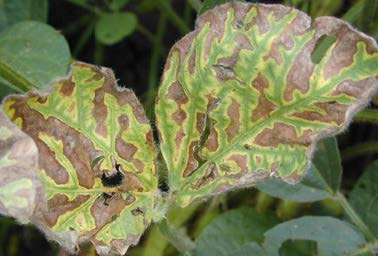
Jun 19, 2023, 4:00 PM
Sudden Death Syndrome (SDS)
 Sudden Death Syndrome, more commonly known as SDS, is becoming more prevalent across many parts of the United States. SDS is a destructive soil-borne disease that can be difficult to manage. Your best management option is to choose varieties that have some resistance to the disease. Recently, there have also been certain seed treatments that offer some control. Remember that there are no foliar fungicide treatments that will prevent or cure this disease.
Sudden Death Syndrome, more commonly known as SDS, is becoming more prevalent across many parts of the United States. SDS is a destructive soil-borne disease that can be difficult to manage. Your best management option is to choose varieties that have some resistance to the disease. Recently, there have also been certain seed treatments that offer some control. Remember that there are no foliar fungicide treatments that will prevent or cure this disease.
Factors to Consider:
SDS doesn’t always show up every year. However, the pathogen overwinters in the soil and will infect the soybean plant if the environment is favorable. Multiple studies have shown that rotating soybeans out of a field with SDS for two years has helped reduce the severity of the disease. SDS is usually most prevalent in compacted and low-lying damp areas. These are a few factors that can lead to SDS flare up in your fields:
- Prolonged cool, wet periods after planting
- Heavy rains during flowering period
- Field history of SDS
- High soybean cyst nematode (SCN) levels
Action Plan:
There are a few control measures that a grower can do to help prevent SDS from occurring. One important thing to keep in mind is that there is no rescue treatment option available, so prevention is the best way to manage the disease.
- Plant varieties with higher SDS tolerances.
- Rotate away from soybeans for at least two years in fields with a history of SDS.
- Utilize a seed treatment labeled for SDS (such as Saltro®).
- Increased drainage and compaction alleviation can help decrease the severity of the disease.
- Avoid planting early in fields with a history of SDS.
- Reduce soybean cyst nematode (SCN) populations with different SCN resistant varieties.
Summary:
SDS can be a devastating disease but can be managed with preventative measures such as selecting soybean varieties with moderate-to-high levels of resistance, using a seed treatment with activity against SDS, and crop rotation.

